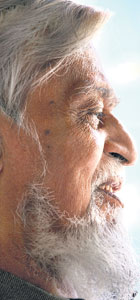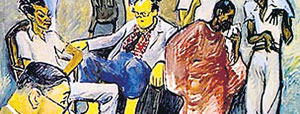
His own canvas of lifeAttributing much of his artistic achievements to meeting the right people at the right time, the 43 Group’s only surviving member, Richard Gabriel speaks to Renuka Sadanandan. Pic by M.A. Pushpa Kumara
Words that strike you, considering that they come from the only surviving member of the 43 Group, this country’s most influential and pre-eminent group of artists. Here on a brief holiday from Australia where he now lives, we meet him in the quiet of his old home in Pannipitiya. On the phone he seems a little reluctant at the prospect of an interview, but his greeting is warm. He last visited two years ago, but this time, the landscape has changed, he says. A trip to Nuwara Eliya has shown him the roadside and hillsides marred by billboards—leaving him saddened by the rampant commercialism that society has been sucked into. Richard Gabriel grew up in a very different island. He was born in 1924 in the seaside calm of Matara, but his father, a postmaster died when Richard was just a babe in arms, two months old, and his mother accepted her brother’s offer of a house in Dehiwela and moved to the city. Richard and his elder brother Edmund went to St. Peter’s College and there Edmund became close friends with a certain Lester James Peiris whose brother Ivan was quite an artist. Lester it was, who introduced Richard to the unlimited pleasure of books, to the Russian novelists, Gogol and Pushkin, an influence he sees today as the reason why he was always drawn to painting the poor and oppressed. Seeing him always sketching, his brother proposed that he meet Ivan. Richard took with him a painting he had done of his father, drawn from his parents’ wedding portrait - while that had his father seated, he chose to draw him standing. Ivan was impressed and thus began a long friendship. He was one of those people, whom today Richard Gabriel, feels he was fortunate to meet, who influenced his work and his thinking. Ivan was also, coincidentally a student of Harry Peiris, one of the established artists of his day, who went on to found not only the Group of 43 but the Sapumal Foundation too. It was wartime and in school, young Richard was also known for making intricate cardboard models of guns and ships, a skill, he says came in handy when he learnt the art of doing woodcuts. It was also the time when a War Effort Exhibition organised by the Department of Information was held and having been encouraged by Ivan to submit some entries, he was thrilled to win four prizes, recognition indeed, that his was no mere schoolboy talent. “Ivan won the first prize and an Inspector of Art, one Mr. Canagasabey won the second,” he recalls. Deeply grateful to Ivan, he remembers approaching his gruff Classics teacher Noel Phoebus for a loan to buy Ivan a gift, a book of Indian paintings which cost Rs. 40, a large sum in those days. Books were difficult to get, he says, but Mr. Phoebus after hearing why he wanted the money, promptly obliged. Meanwhile, having come down in Maths, he had failed his Senior School certificate but he recalls with some emotion, his mother’s wisdom at this point. “She told me God has given you a gift, why don’t you use it,” he says, still amazed that in those days when a government job was considered the path to stability, his mother could be farsighted enough to encourage him to follow his heart.
Success at the exhibition was to open doors for when Ivan was asked by Fr. Peter Pillai to teach Art at St. Joseph’s College he asked Richard. Having known the legendary priest from his schooldays at St. Peter’s, he went to meet him and was dumbfounded when he was asked to start straightaway. “At that time I didn’t even have a pair of longs (he was 19). When I told Fr. Pillai this he said, ‘so borrow one’.” In the end it was Lester who gave him a suit to start work. Lester being shorter than him, he had to have the trouser hem let down but the coat sleeves were still too short. “I remember keeping my arms folded most of that week,” he says, smiling at the memory “I don’t know if the students realized that.” Then Fr. Pillai gave him the money to get a suit and later urged him to re-sit his exam (he emerged with a creditable Second Division) as well as take the teachers’ exam. It was when Lionel Wendt came visiting Ivan and happened to see one of his paintings ‘upside down’ that there came that fateful invitation to join the group of artists who were just getting together for an exhibition- ‘The Group of ‘43’. The venue was a storeroom of sorts down Union Place where Wendt and an Englishman named Thornley, Chairman of Carsons had occasionally exhibited and it fell to the younger members of the Group to get it cleaned and whitewashed. So Ivan and he went to work. Years later Richard Gabriel was to help with whitewashing again, this time a garage- getting it ready for a new art school…the Cora Abraham Art School and there meet a young art teacher Sita Kulasekera who later became his wife. The Group of 43 comprised several diverse and distinct talents. Led by Lionel Wendt, there was George Keyt, Justin Daraniyagala, Geoffrey Beling, Harry Peiris, Ivan Peries, Aubrey Collette, L.T. P. Manjusri, George Claessen and Gabriel himself. That first show drew some adverse reviews, from Daily News editor Padmanabha, he chuckles, but others like Tori de Souza and Denzil Peiris were very supportive. Harry Peiris was the one who did all the organizing and the others were more than content to leave it all in his capable hands. They met infrequently, maybe once in two or three months at Harry’s home or just before an exhibition. “There was lots of discussion, hardly any dissent,” he says. Keyt living in Kandy was rarely present but the others were all there. “It was the best of times.” Lionel Wendt’s untimely death in 1944 was a major blow but they carried on, with Harry as the moving force. The Group’s second and third exhibitions were at Wendt’s house and the subsequent ones at the Lionel Wendt Gallery. Those early paintings sold for as little as Rs. 50 and Rs. 75, he smiles…a Keyt would fetch Rs.100. But recognition was to come both locally and internationally. He received a British Council scholarship to study at the Chelsea School of Art. At the Venice Bi-ennale in 1958, his woodcuts exhibited along with some of the Group fetched record prices. He had the distinction of having one of his paintings bought by the Petit Palais for its permanent collection in Paris. Back home, his works are in many places, most notably religious sites-churches, like at St. Theresa’s, Thimbirigasyaya, a statue of Christ for the Jesuit Fathers at Clifford Place, a series of woodcuts at the National Seminary of Our Lady of Lanka at Ampitiya to name a few. When after almost two decades, the routine of teaching got to him, his wife suggested that he give up his job at St. Joseph’s and concentrate on painting. This, mind you, he says at a time, when people were not willing to pay much for paintings. But they sold and the commissions came in, he says, still sounding surprised. “When I paint a religious picture, I never expect people to buy them. But people did buy…I was living on my work.” He was also doing etchings, he adds, an art he learnt from Ranil Daraniyagala. He pauses to mention another close friend Ranjith Fernando who played a major role in organizing exhibitions for the Group in Europe in the 1950’s. It is to his deep regret that Ranjith whom he was looking forward to meet on this visit died in early March, just before he arrived. Though now living ‘a quiet life’ in Melbourne, Australia, where he migrated in 2002 to be with his son and daughter, he is still working, doing etchings and presently painting on a large canvas, inspired by the story of St. John of God, a 15th Century Spaniard who on the lines of Mother Theresa fed, housed and cared for the poor. Like in all the years past, a painting grows in his hands, he muses. “I don’t look at a sketch and paint. I do the drawing on the canvas and it goes on changing. That is why I say there is an outside force.” |
|
||||||
|| Front
Page | News | Editorial | Columns | Sports | Plus | Financial
Times | International | Mirror | TV
Times | Funday
Times || |
| |
Reproduction of articles permitted when used without any alterations to contents and a link to the source page.
|
© Copyright
2008 | Wijeya
Newspapers Ltd.Colombo. Sri Lanka. All Rights Reserved. |

